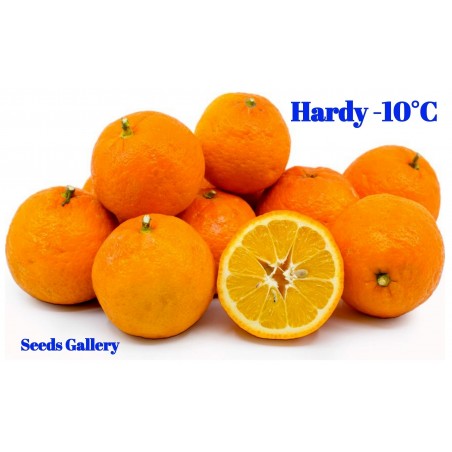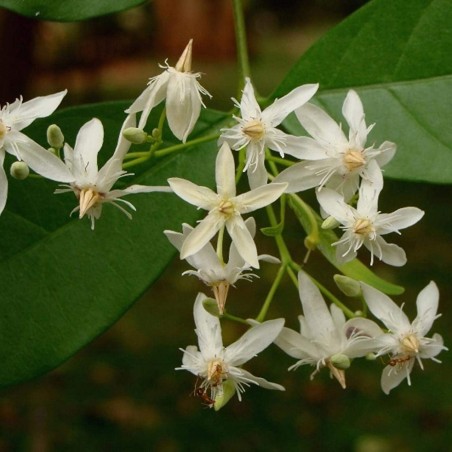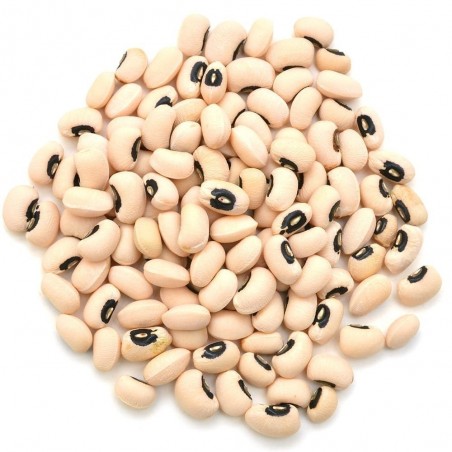
Dyer's oleander seeds (Wrightia tinctoria)
Dyer's oleander seeds (Wrightia tinctoria)
Price for a Package of 10 seeds.
Wrightia tinctoria, Pala indigo plant or dyer's oleander, is a flowering plant species in the genus Wrightia found in India, Southeast Asia, and Australia. It is found in dry and moist regions in its distribution. Various parts of the plant have been used in traditional medicine, but there is no scientific evidence it is effective or safe for treating any disease.
It is a small to medium-sized deciduous shrub or tree, ranging from 3 m to 15 m in height but also reaching up to 18 m. The bark is smooth, yellowish-brown, and about 10 mm thick, producing a milky-white latex. Leaves are simple, oppositely arranged, ovate, obtusely acuminate, and are 10–20 cm long and 5 cm wide. Leaves are glabrous and sometimes pubescent beneath.[2] Leaf stalks are very short. The flowers appear (in India) from March to May, peaking from April to June. White flowers appear in corymb-like cymes, 5–15 cm across, at the end of branches. Flowers have five white petals 2–3 cm long which turn creamish yellow as they age. The flowers have oblong petals which are rounded at the tip and are similar to flowers of frangipani. Fruiting is in August and the fruit is cylindrical, blackish-green speckled with white, long horn-like, and united at the tip. The seeds are brown and flat with a bunch of white hairs. Seed dispersal is by wind and pollination is by insects. In his 1862 book on timber trees of South Asia, Edward Balfour mentions its distribution across the then Madras Presidency of British India especially in the Coimbatore jungles, and reports that it was "very common in all forests of Bombay". In the same book, Balfour quotes William Roxburgh's comparison of the whiteness of the wood as "coming nearer to ivory than any I know". Earlier in 1824, the plant specimens were presented by the British East India Company to the Royal Horticultural Society as illustrated and recorded in the botanical register founded by Sydenham Edwards and at the time published by James Ridgway.
Phytochemistry
The plant contains wrightial, a triterpenoid phytochemical, along with cycloartenone, cycloeucalenol, β-amyrin, and β-sitosterol isolated from the methanol extract of the immature seed pods.
Distribution and habitat
It is mainly found in Australia, India, Myanmar, Nepal, Timor, and Vietnam. Within India, it is found in most of the peninsular and central India except the northern and north-eastern states.
Ecology
It is a slow to moderate-growing plant. Plants commence flowering when about 5–8 years old. It grows in a wide range of soil types ranging from arid, semi-arid, gravely or rocky soils and moist regions, especially on dry sandy sites or hillsides and valleys. The tree responds well to coppicing, and also produces root suckers. It tolerates moderate shading and is often found as undergrowth in deciduous forests. It also tolerates high uranium levels in soils. In India, the fungus Cercospora wrightia is known to cause leaf spot disease of Wrightia tinctoria.
Uses
The flowers, leaves, fruits, and seeds are edible. The tree is harvested from the wild as a medicine and source of dye and wood. Leaves are extracted as fodder for livestock. The leaves, flowers, fruits, and roots are sources of indigo-yielding glucoside, which produces a blue dye or indigo- like a dye. About 100–200 kilos of leaves are needed to prepare 1 kilo of dye. It is occasionally planted as an ornamental in the tropics. The branches are trampled into the puddled soil in the rice field for green manuring. It is recommended as a good agroforestry species as it intercrops well. Bharath art and crafts artisans said the wood of Wrightia tinctoria is used extensively in Channapatna (a toy town of India) for carving and lacquer work of world-famous Channapatna Toys. The timber is high in quality and value. The white wood is used for turnery, carving, toy making, matchboxes, small boxes, and furniture. High levels of extraction are resulting in it becoming scarce in some regions. The sap added to milk has been reported to have preservative properties; the milk will remain fresh for some time, the taste remaining unaltered.
Traditional medicine
In Ayurveda and other traditional medicine practices, the plant is called shwetha kutaja and its seeds are called indrayava or indrajava. There is no high-quality clinical evidence that it is safe or has any beneficial effect.
| Organic Seeds ? | Organic Seeds |
|---|---|
| Organic/natural ? | Organic/Natural: Yes |
| Edible ? | Edible |
| Pretreatment of sowing ? | Soak in water before sowing 12-24 h |
| Sowing depth ? | Sowing depth 1 mm |
| Life Cycle: | Perennial plant : Yes |
| Handpicked seeds ? | Handpicked seeds |
| Origin of seeds ? | Origin of Seeds: India |
| Origin Country of Variety ? | Variety from: India |
| Medicinal Plant ? | Medicinal Plant: Yes |


Your review appreciation cannot be sent
Report comment
Report sent
Your report cannot be sent
Write your review
Review sent
Your review cannot be sent
🌍 Worldwide Shipping from the EU
We ship worldwide from the European Union using registered air post with signature confirmation on delivery.
📦 Tracking Your Order
Log in to your account and go to Order History > Details to find your tracking number.
You will receive email notifications at every step — please check your spam/junk folder if you don’t see them.
Track your package via:
⚠️ Important Notices
Cash on delivery is not available.
Always provide a valid mobile number with country code when ordering (e.g., +365 456 7686 576).
Do not order to P.O. Boxes or if you cannot be home to sign for the package. We cannot leave parcels with neighbors.
If a package sent to a P.O. Box is lost or undelivered, you lose the right to a refund.
📦 Lost, Returned & Reshipping Packages
For customers in Brazil and Mexico:
We cannot refund packages lost or destroyed by customs.
If your package is returned, we will refund only the product cost — shipping costs are not refundable.
You must pay return postage (€2) and any costs for reshipping.
If a package is returned to us for any reason, you are responsible for paying the return shipping (€2) plus the cost to resend the package.
🚚 Shipment Delivery
Registered shipments require a signature from the recipient.
If your tracking shows the package is still at the origin post office, it means the package is in transit — please contact your local post office directly for updates.
We are not responsible for delivery times and cannot track shipments for you.
📅 Delivery Options & Estimated Times
Delivery Option Processing Time Notes Priority Delivery Ships in 1-7 business days Prioritizes order processing (not guaranteed faster delivery); delays possible during holidays (3-10 days) Secured Delivery Ships in 1-7 business days Available for orders up to €150; refund if lost Standard Delivery Ships in 7-10 business days More economical; delays possible during holidays (7-14 days) Estimated Delivery Time:
Within the EU: 3–20 days
Worldwide: 5–30 days
Example delivery times to the USA:
Delivered in 13, 17, 19, 22, or 27 days.Note: Delivery times depend on your location and the local postal system. COVID-19 may cause additional delays.
💰 Shipping Costs
Shipping and handling fees are calculated automatically during checkout based on the weight of the parcel and the destination country.
⏰ Order Processing Hours
We do not process or ship orders on Saturdays or Sundays.
💳 Payment Options
Bank Transfer (SEPA / IBAN / SWIFT-BIC)
Include your order reference in the payment description (e.g., "SGS-19811702"). Orders without payment within 7 days are automatically cancelled.PayPal
Payments accepted in Euros only. Please select Euros at checkout.Card Payment
For card payments, visit our other site: Exotic Seeds Store
We accept Visa, MasterCard, American Express, CB, Diners Club, Discover, China UnionPay, JCB, and Discover.
⚠️ Transaction Fees
Customers are responsible for any transaction fees. Please provide payment details to help us process your order efficiently.
📢 Final Notes
Before placing your order, please check our website for any special notices, holiday schedules, or specific conditions that may affect your purchase.
Related Products















